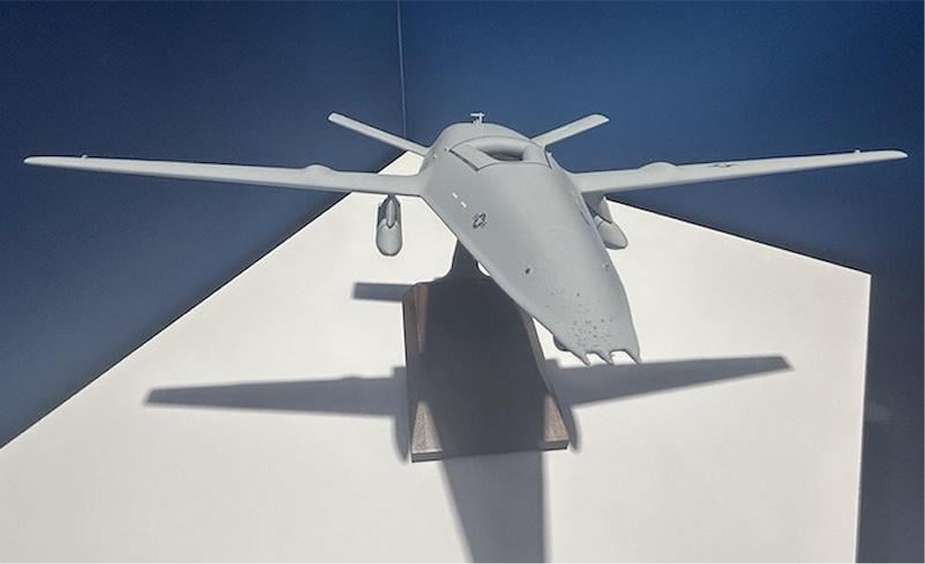Boeing and Lockheed Martin collaborate on an armed variant of the MQ-25 tanker drone
As reported by Aviation Week on April 9, 2024, Boeing unveiled a model of an armed variant of the MQ-25 Stingray tanker drone at the Sea Air Space Exposition 2024. This version of the carrier-based tanker drone is equipped with two Lockheed Martin AGM-158C Long Range Anti-Surface Missiles (LRASMs), illustrating the potential expansion of the drone's mission profile beyond aerial refueling as the US Navy is reevaluating the potential roles for the MQ-25 drone.
Follow Army Recognition on Google News at this link

This version of the carrier-based tanker drone is equipped with two Lockheed Martin AGM-158C Long Range Anti-Surface Missiles (LRASMs). (Picture source: Aviation Week)
According to Rear Admiral Stephen Tedford, the Navy’s program executive for unmanned systems and weapons, the US Navy is assessing the feasibility of incorporating autonomous combat drones on aircraft carriers. Speaking at the Sea Air Space 2024, Tedford stated that these drones would need to be cost-effective, with a price cap of approximately $15 million each.
These drones, referred to as Collaborative Combat Aircraft (CCA), are designed with a notably short operational lifespan, anticipated to only last a few hundred flight hours. Tedford described their use as follows: “I want something that’s going to fly for a couple hundred hours. The last hour it’s either a target or a weapon... But I’m not going to sustain them for 30 years.” Essentially, these drones will conduct several surveillance and strike missions before their final deployment, where they might serve as kamikaze drones or targets in training exercises.
This initiative marks a departure from earlier approaches, notably after the cancellation of the Unmanned Carrier-Launched Airborne Surveillance and Strike (UCLASS) program in 2016, which was initially focused on developing a multi-role combat drone and ultimately led to the conceptualization of the MQ-25. However, the program was restructured into the Carrier-Based Aerial Refuel System (CBARS), which redefined the MQ-25's role to primarily focus on aerial refueling. Since then, the MQ-25 program has encountered delays and cost overruns: initially expected to achieve initial operational capability in 2024, this milestone has now been postponed to 2026.
The US Navy is now initiating studies to determine the necessary payloads, sensors, and mission systems for these UCLASS-inspired drones, aiming to complement the capabilities of current manned fighters like the F/A-18E/F Super Hornet and the F-35 Joint Strike Fighter. Furthermore, the Navy is monitoring related programs and technological advancements, including the Royal Australian Air Force’s MQ-28 Ghost Bat program and the U.S. Air Force's developments in artificial intelligence. With this approach, the UCLASS-inspired drones are expected to be integrated into the US Navy's service in the latter half of this decade, with an emphasis on modular and adaptable design to avoid limitations imposed by proprietary technologies, but also to ensure compatibility and flexibility in operations and upgrades.

Concurrently, the US Navy continues to prioritize the MQ-25 tanker drone, a project led by Boeing that aims to achieve operational capability by 2026. (Picture source: Boeing)
Concurrently, the Navy continues to prioritize the MQ-25 tanker drone, a project led by Boeing, which is on track for its inaugural flight next year and aims to achieve operational capability by 2026. Despite the difficulties associated with integrating new technologies with existing tactical and logistical requirements, the potential for the MQ-25 to undertake kinetic roles has remained under consideration. Prior to Boeing's selection for the MQ-25 contract, Lockheed Martin proposed a version of the drone capable of strike missions, indicating ongoing interest in leveraging the platform for expanded military applications.
At the Sea Air Space Exposition 2024, the display of the MQ-25 equipped with Long-Range Anti-Surface Missiles (LRASMs) highlighted the drone's potential capability for engaging in anti-ship and surface strike missions. The LRASM is designed for operations in contested environments, equipped with an advanced guidance system that includes GPS-assisted inertial navigation and a terminal-phase passive imaging infrared sensor. This missile is part of the Navy’s current arsenal, deployable from F/A-18E/F Super Hornets and with plans for future integration onto other platforms such as the P-8A Poseidon and F-35 Joint Strike Fighters.
The MQ-25's design incorporates features intended to enhance its survivability and versatility, derived from its initial development as a combat drone. These characteristics are essential for operations in regions where threats to carrier groups include advanced anti-access/area-denial (A2/AD) systems. The drone's considerable fuel capacity enables it to operate at extended ranges, potentially deploying missiles like the LRASM from distances that reduce the risk to the carrier group.
The MQ-25 Stingray is an unmanned aerial refueling aircraft designed by Boeing for the U.S. Navy. As a carrier-based drone, it facilitates aerial refueling, thereby extending the operational capabilities of combat aircraft such as the F/A-18 Super Hornet, EA-18G Growler, and F-35C fighters. The aircraft is powered by a Rolls-Royce AE 3007N turbofan engine and designed with features like a stealthy fuselage and a V-tail to improve its survivability. The MQ-25 can carry 15,000 pounds of fuel over 500 nautical miles and can be integrated with US carrier operations without major changes to existing procedures.
Looking ahead, the MQ-25 is expected to not only enhance the operational effectiveness of carrier air wings by assuming aerial refueling duties from F/A-18s but also potentially to serve as a platform for advanced surveillance, reconnaissance, and strike missions. This evolution is in line with the Navy's strategic goals of increasing the unmanned capabilities of its air wings to 60 percent by 2040, indicating a significant shift in US naval aviation tactics and strategy.
- Hits: 4490
















